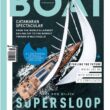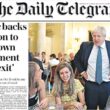It’s just a year since Jon Steinberg became the UK-based CEO of magazine-centric Future Plc. He told investors at his first-half results presentation in May 2023 he was excited to have “the opportunity to build on the unique position” of the publisher. He said the diversification strategy (which had increased revenue and profit by more than 35% with record margins only the year before his appointment) was delivering solid results. Its longtime focus on specialist, consumer passions and evergreen, expert content had become more valuable than ever. Its emphasis on revenue diversity was an idea whose time had come.
But the new CEO’s infectiously enthusiastic words didn’t quite match the numbers as he sought to explain how his new company had abruptly lost its growth, just before he arrived.
A year later, some things have changed.
This week, Steinberg celebrated his first anniversary at Future by unveiling results for the six months ended 30 March 2024. Arguably, he had a yet tougher task than 12 months before: revenue and EBITDA were down by 3% and 20% respectively – and the results were now “his”.
But, despite the decreases, there were some real positives from a company which – even amid the jitters of the last two years – has been strongly cash-generative. The CEO pointed to the 119% cash conversion of its operating profit (fuelled by UK magazine subscriptions), paying down 19% of its £365mn borrowing, and £45mn of share buybacks with plans to repeat them in 2024-5. Digital advertising revenue in the US is rebounding, giving Future 3% growth in the second quarter..
Stockmarket investors didn’t know what to make of the results with the share price always up but fluctuating between a rise of 30% and just 10%. It’s mirror of the company’s recent experience with a share price rise of 30% in the past week and also YTD. But its been flat on the past 12 months. Investors don’t know what to think about a company with a messy history that had a stellar run under previous CEO Zillah Byng-Thorne – and manages to combine its cash-generative virtue with the worries of a print portfolio of 100 magazines and 700 bookazines.
Future’s latest results underline the challenge:
| Future Plc Six months to March 31 £mn | 1H 2023-24 | 1H 2022-23 | Variance |
| Revenue | 391.5 | 404.7 | -3% |
| Magazines | 130.3 | 139.2 | -6% |
| Advertising | 112.8 | 128.8 | -12% |
| Go.Compare | 96.1 | 73.8 | +30% |
| eCommerce | 52.3 | 62.9 | -17% |
| EBITDA | 113.9 | 141.9 | -20% |
| Margin | 29% | 35% |
The fact is that the standalone GoCompare – the price comparison site acquired in 2021 for £594mn (20x its likely EBITDA in 2024) – provided the only revenue growth. It may also have accounted for as much as 30% of total first-half profit. Future, incidentally, seeks to blur the GoCompare standout and also the continuing fall in its core eCommerce by combining the two revenue streams in its financial reporting.
However successful, GoCompare is surely an ancillary business for Future, not least because tight UK financial regulation precludes almost any data sharing with the publishing business. You might also worry that GoCompare’s strong performance reflects a buoyant car insurance market in which it is, arguably, the no.3 player. So you can guess what might happen to this ultra-cyclical business in the next downturn. But, for now, it’s making a vital contribution to Future which might otherwise have been reporting revenue down by 11% and profit down by 28%.
But every company has its secrets – operations whose financial importance are greater than anyone can guess. (Ask Dotdash Meredith about the 20% of its profit generated by its magazine-branded retail licensing: it’s hidden in digital revenue).
Perhaps GoCompare is like that: its c25% share of Future’s revenue is generated by fewer than 5% of the 2,900 headcount. But it really can help to power the transformation from a (still) mainly print publisher into a full-blown digital operator, directly competing in the US with the likes of Ziff Davis, Red Ventures and Dotdash Meredith.
It’s a long journey.
Last year, the Future CEO analysed his sprawling transatlantic portfolio variously as “hero”, “halo” or “cash generator” brands:
| Future Plc 1H revenue | % of group revenue | No. of brands | +/- 2024 v 2023 | % of group profit** |
| Hero brands | 50% | 12 | +3% | 70% |
| Halo brands | 30% | 70 | +3% | 15% |
| Cash generators | 20% | 150 | -19% | 15% |
The analysis prompted more questions because the company has never actually confirmed even the number of brands in each category, let alone their identity. At yesterday’s results presentation, Steinberg again declined to issue a list saying the categories were “fluid”. We can think of some good motivational reasons why profiling the company’s teams as belonging to such categories could be problematic. But the main criticism of revealing how concentrated are the company’s major “hero” profitmakers is that it did not actually reflect any kind of organisational change; it was just arithmetic. And the 19% reduction in revenue of the “cash generators” (above) seems almost satirical.
The real organisational change came earlier this year with the announcement that Future is now being managed globally as three divisions: B2C, GoCompare and B2B. But the fact that B2C comprises a mighty 72% of the revenue in the US and UK (GoCompare is 20% and B2B is just 8%) and is now to be managed as a single “division” creates even more questions about execution of the strategy.
It all comes back to Steinberg’s “Hero” brands.
These 12 “best” brands may generate at least 70% of profit as well as 50% of revenue – and they may include only seven (of the company’s 100+) print magazines. They underline the challenge for Future:
- Most of its people are employed on print media
- It would be more profitable with fewer (print) brands
- The long tail of print brands could be at least as profitable for other publishers. Many would be highly prized, some still very profitable but non-core to Future
- Divestments could liberate people and resources to expedite Future’s digital growth
It is important to say that print media – in so many areas of publishing – is proving more resilient than might once have been forecast. And we can think of many ways in which print subscribers can be used to create a runway to the dream world where consumers can be ‘trained’ to pay for digital content. It’s what quality news brands are starting to prove.
But Future websites mostly still concentrate on selling magazine subscriptions not digital membership. They emphasise the way that the print portfolio may be more about milking legacy brands for profit than building the digital runway. It means that, as the economic challenges of print grow, the company may find it increasingly difficult (and expensive) to manage an emerging digital business alongside a large legacy one.
Future is not, of course, the first traditional media group to face the challenge. But – at a time when it is committed to staying away from acquisitions – perhaps Jon Steinberg will go back to the calculations of his “Hero” brands, and ask himself:
“Future would be more profitable with a dramatic reduction of its portfolio, especially in the UK – even though most of the brands make some kind of contribution to profits. Is there a way we could divest many of these legacy brands to smaller companies and/or joint ventures which might pay little or nothing upfront in exchange for guaranteeing medium-term royalty payments to Future from upcoming profits? Could Future enhance its profits – and reduce the management ‘distraction’ – by “securitising” the profits in this way? Wouldn’t that be a win-win?”
Steinberg has been working hard to re-engineer the business by, for example, investing more in content, sales and people – and conditioning investors to accept EBITDA margins below the 35% peak of 2023. But in a cookie-restricted world of competition for the investment and collaboration of AI leaders, there’s so much to do in order to build digital competitiveness.
That’s only the start for a CEO who was recruited primarily for his prized expertise in digital media and the US market. As the UK’s largest magazine group approaches the 40th anniversary of its 1985 launch by TED’s Chris Anderson, his latest successor might just focus on the tantalising promise: a sharply reduced print portfolio and no-sweat, guaranteed funding from new owners of low-growth but good quality magazines.
Jon Steinberg could concentrate on the real future of Future. Just think.
| Future Plc £mn SnapShot | 2024 | 2023 | 2022 | 2021 |
| Revenue | 794 | 789 | 825 | 607 |
| Digital ads | 246 | 262 | 187 | |
| eCommerce | 111 | 127 | 106 | |
| Magazines | 274 | 290 | 184 | |
| GoCompare | 158 | 146 | 110 | |
| UK | 60% | 60% | 65% | |
| US | 40% | 40% | 35% | |
| EBITDA | 246 | 277 | 294 | 215 |
| Margin | 31% | 35% | 33% | 32% |
| Net cash/ (debt) | (266) | (327) | (424) |




